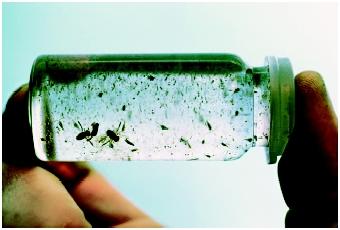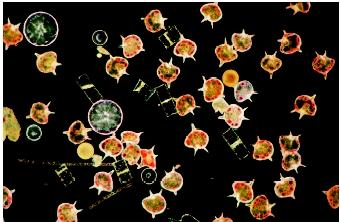Plankton
Awareness is growing regarding the importance of the oceans and the variety of life they support. Research in many branches of oceanography is discovering the vast unknown of the marine world, and has expanded interest in the understanding of the marine environment and the role each member plays in a complex community.
The free-floating organisms known as plankton, from the Greek "wandering," are the drifters of the ocean. Although most of these organisms are motile (moving), they cannot swim or move against currents, but they can move vertically in the water column.
Many marine plankton are found in the deep waters of the outer ocean, or pelagic waters, whereas others are found in the shallow waters known as the neritic zone. Many of the neritic plankton are known as meroplankton, and spend only a brief period of their life cycle in the planktonic category. Many pelagic forms, such as the holoplankton, are planktonic during their entire lifespan.
The size of plankton can also determine its general name.
- Picoplankton: Smaller than 2 μ m ; includes bacteria, prochlorophytes, and viruses
- Nanoplankton: 2 to 20 μm; includes diatoms, coccoliths, and silicoflagellates
- Microplankton: 20 to 200 μm; includes large diatoms, dinoflagellates, and small zooplankton, such as ciliates
- Macroplankton: 200 to 2,000 μm; includes large zooplankton, copepods, and invertebrate larvae
- Megaplankton: Larger than 2,000 μm; includes fish larvae and gelatinous zooplankton
Phytoplankton
Many kinds of marine and fresh-water organisms utilize inorganic carbon (as carbon dioxide) and fix it into organic compounds by photosynthesis .

Diatoms.
Diatoms have cell walls of silica and pectin, and float in the water column or attach to surfaces as single cells or chains. They are one of the major contributors to primary production in coastal waters, and occur everywhere in the ocean, but are most abundant in colder, nutrient-rich, nearshore waters. Cell division occurs by fission, which is accompanied by a reduction in cell size. They are one of the principal groups that fix carbon through photosynthesis, and this production is prominent during seasonal blooms of short duration.
Dinoflagellates.
Dinoflagellates occur as single cells, either naked or within a cellulose cell wall, and many species use flagella to move. These organisms are sometimes classified as protozoa and algae because of their ability to photosynthesize and also absorb nutrients by being parasitic, or by ingesting organic particles. They are second to diatoms in contributing to primary production, and are widespread in the oceans, but are most abundant in nutrient-poor waters offshore. Reproduction is by cell division. Some species are bioluminescent (emitting a pale blue glow seen at night). Dinoflagellates often are the cause of red and brown tides, so named because the algal pigments give the water a colored tint.
Coccolithophorids.
Coccolithophorids are single-celled organisms. Many are flagellated, and are protected by ornate calcareous plates, called coccoliths, embedded in a gelatinous sheath that surrounds the cell. These organisms may form cysts that produce spores to produce new individuals. They are most abundant in warm, open-ocean waters, and are sometimes found nearshore. * Coccolithophores can photosynthesize (autotrophic) and may also absorb organic matter (heterotrophic).

Silicoflagellates.
Silicoflagellates occur as single flagellated cells and typically secrete a silicious outer skeleton. Like coccoliths, these organisms are both autotrophic and heterotrophic , and are most abundant in cold, nutrient-rich waters.
Bacteria.
Bacteria are prokaryotes with cell walls made of chitin , and occur as single coccoid cells or long filaments. They often are restricted to waters with low oxygen, and are important in the metabolism of aquatic ecosystems. To support their metabolism, they obtain nutrients by the uptake of organic matter and the release of exoenzymes to lyse (distintegrate or dissolve) particulate organic matter, and attack diatoms, dinoflagellates, and flagellates. Blue-green algae, or cyanobacteria, are photosynthetic. Bacterial activity in marine waters is strongly affected by availability of nutrients and organic matter. Their productivity increases as phytoplankton productivity increases.
Viruses.
Viruses play an important role in marine food webs. They infect a wide range of hosts, including bacteria and phytoplankton. They can potentially reduce phytoplankton and bacterial production by viral lysing of their cells and the releasing of dissolved organic carbon. This dissolved carbon can than be utilized by other phytoplankton cells.
Prochlorophytes.
Prochlorophytes are a recently discovered group of extremely abundant producers that are barely visible by microscopy. They are most abundant at the lower layers of the illuminated region of the water column, and are now considered to be another major player in primary production.
Nanoflagellates.
Nanoflagellates are both autotrophic and heterotrophic. They feed on viruses, bacteria, and some picoplankton and nanoplankton. Nanoflagellates are major consumers of bacteria; some experiments show that they may be able control their abundances when larger predators, such as dinoflagellates, are not present. However, this is less likely to occur in nature.
Protozoans.
Nanoplanktonic and microplanktonic protozoan groups are mainly ciliates and heterotrophic dinoflagellates. They consume bacteria, nanoplankton, and microplankton. While these groups engulf their prey, they also release nutrients that stimulate the growth of these same prey.
Zooplankton
Zooplankton are planktonic free-floating animals in fresh and marine aquatic systems, and are the major consumers of the organisms in the microbial food web. These organisms possess a wide range of feeding strategies, from the nematocysts (stinging cells) of cnidarians (e.g., jellyfish) to the complicated mouthparts of copepods. Some are carnivorous (animal-eaters), some are herbivorous (plant-eaters), and some are omnivorous (eaters of plants and animals).
These animals can move by means of cilia, flagella, jointed appendages, jet propulsion, or tailed larvae (as in tunicates to larval fish). Reproduction varies from asexual, to fission and fragmentation, to sexual reproduction where some gametes are released into the water and fertilized, yet others are retained and fertilized internally.
Zooplankton include many phylum, and not all can be discussed here. Some live their entire life cycle in the water (holoplankton), whereas only the larval stages of fish and other benthic organisms (such as starfish) live in the water column for a short time (meroplankton). All are considered zooplankton. An overview of the major zooplankton phyla follows.
Protozoa.
Discussed previously, this group includes ciliates, dinoflagellates, foraminifera, and radiolarian.
Coelenterata (Cnidaria).
Typically known as jellyfish, the major groups are Hydrozoa, Scyphozoa, and Anthozoa. The hydrozoans medusae are the prominent members in zooplankton, and the most common forms are aurelia, pelagia, and siphonophores. These gelatinous animals are major consumers of smaller zooplankton and some of the microbial food web.
Ctenophora.
Best known as comb jellies, these possess eight "comb" rows of fused cilia. When they are abundant, these animals can consume phytoplankton and zooplankton, and can clear the water of food for other zooplankton.
Chaetognatha.
Known as the arrow worm, this is a common member of deep-water plankton. Smaller species are found in coastal waters, whereas larger species are abundant offshore in blue water. They are predacious carnivores that grasp their prey and paralyze them before ingesting them.
Annelida.
This includes many species of marine polychaetes. Many of these organisms can be seen on the surface at night, shedding gametes for sexual reproduction. Their larvae are abundant in the zooplankton community.
Mollusca.
This includes marine gastropod larvae, pteropods, and cephalopods (commonly known as squid and octopus). * Mollusks are consumers of larger zooplankton.
Echinodermata.
This includes starfish, brittle stars, and sea cucumber. All these animals are meroplankton. Their larvae are a major presence in the zooplankton community.
Arthropoda.
These are the major members of zooplankton and include copepods, shrimp, crabs, lobsters, amphipods, crustaceans, and euphausids, or krill, which are the major source of nutrition for some whales. * The most studied of crustacea are the copepods. These animals are found in all parts of the world's oceans, lakes, and estuaries and are considered the major consumers of most of the organisms in the microbial loop. Because they are holoplankton, spending their entire life in water, they can consume a wide range of food particles, from nanoplankton to microplankton, as they mature. Copepods are responsible for much of the carbon energy transferred from phytoplankton to larger zooplankton.
Chordata.
Known as the urochordates (tunicates), this includes ascidians (or sea squirts) and are found on the coast, whereas larvaceans, oikopleura, thaliaceans, salps, and doliolids are pelagic and spend their entire life cycle in the water column. Tunicates are now realized to be major consumers of phytoplankton and smaller zooplankton, and can contribute to the entire food-web dynamics as much or even more than copepods.
Larvaceans have retained their notochord and tail as adults and produce a mucus net, or "house," around their bodies to capture food particles. The house is either ingested or abandoned.
The salps and doliolids are free-swimming tunicates with a cylindrical or barrel-shaped body with up to eight muscle bands to aid in swimming by jet propulsion and feeding with an internal mucus net. These animals have a complicated life cycle that includes a sexual stage and one or two asexual stages. They are known for their ability to create "blooms," or a rapid increase in their abundance, exceeding 1,000 animals in a cubic meter of water in a short period of time. With this rapid increase in population and their ability to filter feed a wide range of food sizes, they can outcompete copepods during these bloom events. Their role in the food web is being studied more intensely because of their production of large, fast-sinking fecal pellets that can transfer organic matter produced by primary producers to fish and benthic organisms.
SEE ALSO Algal Blooms, Harmful ; Algal Blooms in the Ocean ; Cephalopods ; Crustaceans ; Ecology, Fresh-Water ; Ecology, Marine ; El NiÑo and La NiÑa ; Lakes: Biological Processes ; Life in Water ; Microbes in the Ocean ; Ocean Biogeochemistry .
Deidre M. Gibson
Bibliography
Barnes, R. S. K., and K. H. Mann. Fundamentals of Aquatic Ecosystems. Oxford, U.K.: Blackwell Scientific Publications, 1980.
Parsons, T. R., M. Takahashi, and B. Hargrave. Biological Oceanographic Processes, 3rd ed. Oxford, U.K.: Pergamon Press, 1984.
Smith, Deboyd L. A Guide to Marine Coastal Plankton and Marine Invertebrate Larvae. Dubuque, IA: Kendall/Hunt, 1977.
Valiela, Ivan. Marine Ecological Processes, 2nd ed. New York: Springer Verlag, 1995.
* See "Algal Blooms in the Ocean" for a photograph of a coccolithophore bloom near the coast.
* See "Cephalopods" for a photograph of an octopus's suction-cupped tentacles, and the Nautilus.
* See "Crustaceans" for photographs of crustaceans, and "Ecology, Marine" for a photograph of a krill swarm.
Comment about this article, ask questions, or add new information about this topic: